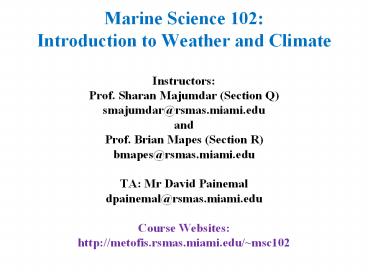Marine Science 102: Introduction to Weather and Climate - PowerPoint PPT Presentation
1 / 23
Title:
Marine Science 102: Introduction to Weather and Climate
Description:
Marine Science 102: Introduction to Weather and Climate Instructors: Prof. Sharan Majumdar (Section Q) smajumdar_at_rsmas.miami.edu and Prof. Brian Mapes (Section R) – PowerPoint PPT presentation
Number of Views:59
Avg rating:3.0/5.0
Title: Marine Science 102: Introduction to Weather and Climate
1
Marine Science 102 Introduction to Weather and
Climate Instructors Prof. Sharan Majumdar
(Section Q)smajumdar_at_rsmas.miami.eduandProf.
Brian Mapes (Section R)bmapes_at_rsmas.miami.eduTA
Mr David Painemaldpainemal_at_rsmas.miami.eduCou
rse Websiteshttp//metofis.rsmas.miami.edu/msc1
02
2
Weather Map Links
http//www.hpc.ncep.noaa.gov weather
animations http//www.spc.noaa.gov storm
watches and warnings http//www.nhc.noaa.gov -
hurricanes
3
- What are Weather and Climate?
- Weather is the condition of the atmosphere at a
particular moment - Precipitation, temperature, wind speed and
direction, relative humidity, dewpoint, cloud
cover, - METEOROLOGY is the study of the science of
weather. - Climate is the condition of the atmosphere over
many years - Long-term averages of temperature, moisture,
winds, clouds, precipitation,
4
- Climate is what you expect, weather is what you
get! Robert A. Heinlein - Ed Lorenz (MIT) The Father of Chaos
5
Syllabus
- Broken into 3 sections
- (i) Fundamentals (ii) Weather (iii) Climate
- Syllabus (subject to change)
- http//metofis.rsmas.miami.edu/msc102/schedule.ht
ml
6
Grades
- Exams (70)
- 3 exams (Feb 17, Mar 26, Apr 30)
- Short answers.
- No Final Exam.
- Quizzes (30)
- 6 Pop quizzes at beginning or end of class.
- Easy.
7
Textbook
OR
8
Rules
- Arrive on time.
- Cell phones, Laptops, iPhones etc off.
- No talking, txting, reading non-class material
- No copying in quizzes / exams.
- Deduction in grade for violations.
9
Chapter One Composition and Structure of the
Atmosphere
10
- Chapter 1 Outline
- Composition of the Atmosphere
- Physical Properties
- Composition
- Evolution of the Atmosphere
- Important Trace Gases
- Water vapor (H2O)
- Carbon Dioxide (CO2)
- Ozone (O3)
- Others Aerosols, Methane,
- Vertical Structure of the Atmosphere
- Pressure and Density
- Other Planetary Atmospheres
11
Making an Atmosphere Gases and Gravity
12
- Physical Properties
- A mixture of gas molecules and very small
particles of solid and liquid. - Behaves as a fluid!
- The majority of atmospheric mass is contained in
a rather thin layer near the surface (99.9 is
below 50 km). - Compared with the radius of the Earth (6500 km),
the atmosphere is very thin (50 km or 1). - Atmospheric motions (winds) are largely
horizontal rather than vertical.
13
Composition of the Atmosphere
78 Nitrogen
20 Oxygen
Remaining 2 trace gases (argon, carbon dioxide,
water vapor, methane, ozone, chlorofluorocarbons,
aerosols)
14
Permanent vs. Variable Gases
Methane CH4
15
(No Transcript)
16
Evolution of the Atmosphere
- Solar System Formed (6 billion years ago)
- Planets form from left over dust/gas
- Earth Formed (4.5 billion years ago)
- Initially hot atmosphere consisting mainly of
hydrogen, helium - Lightest gases (H, He) escaped gravity into space
- Secondary Atmosphere from Volcanic Emissions
- Water vapor (85), Carbon dioxide (CO2 10) and
Nitrogen (lt5) - Nitrogen is chemically stable no reactions with
gases or Earth - Oceans Form
- Water vapor condensed and formed clouds as Earth
cooled - Precipitation formed oceans (and rivers, lakes
and glaciers) - CO2 dissolved in the ocean Nitrogen built up in
atmosphere. - Oxygen
- Produced by green-blue algae that evolved in the
ocean - Photosynthesis absorbs CO2, releases oxygen
17
Evolution of the Atmosphere
3 BY old fossil
18
Important Trace Gases
- Carbon Dioxide (CO2)
- Water Vapor (H2O)
- Ozone (O3)
- Methane (CH4)
- Aerosols (solid particles, not a gas)
19
Trace Gases Carbon Dioxide (CO2)
- Carbon Dioxide
- A trace gas accounting for only 0.036 of total
atmospheric mass - Important to Earths greenhouse effect
- Greenhouse effect gases absorb radiation emitted
by Earth warming - Naturally occurring.
- Added through respiration (breathing), volcanic
activity, organic decay, diffusion from ocean and
natural and human-related combustion - Removed through photosynthesis, diffusion into
ocean, weathering of rocks.
- Human contribution
- Atmospheric CO2 has increased over the past 200
years due to burning fossil fuels. - Spring maximum/Fall minimum reflects breathing
of land plants.
20
500,000 Year Record of CO2
Current CO2 360 parts per million
21
Carbon Reservoirs (GTC)
Reservoir An area of carbon storage. 1 GTC 1
gigaton 1015 g
750
Input (sources) Removal (sinks)
Decomposition
650
36000
4000?
22
Carbon Fluxes (GTC/yr) Pre-Industrial
Flux The exchange of carbon between reservoirs
750
Input Removal
120
lt1
120
lt1
0
Decomposition
90
90
650
36000
4000?
Atmospheric Residence Time 750 GTC / (90120 GTC
yr-1) 3 yr
23
Atmospheric Residence Time
- Atmospheric Residence Time The average time a
molecule of a particular gas resides in the
atmosphere. - Residence Time Amount in Reservoir / Rate of
Input - Carbon Dioxide (CO2)
- 750 Gigatons / 210 Gigatons per year 3.6
yr Variable - Oxygen (O2)
- 750000 Gigatons / 400 Gigatons per year 2000
yr Well mixed































